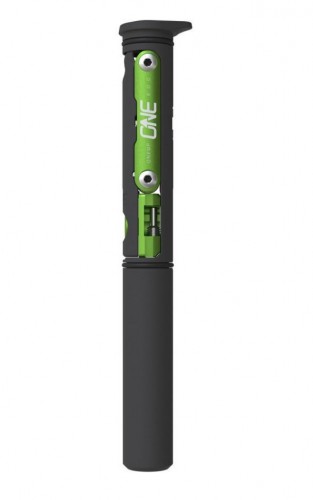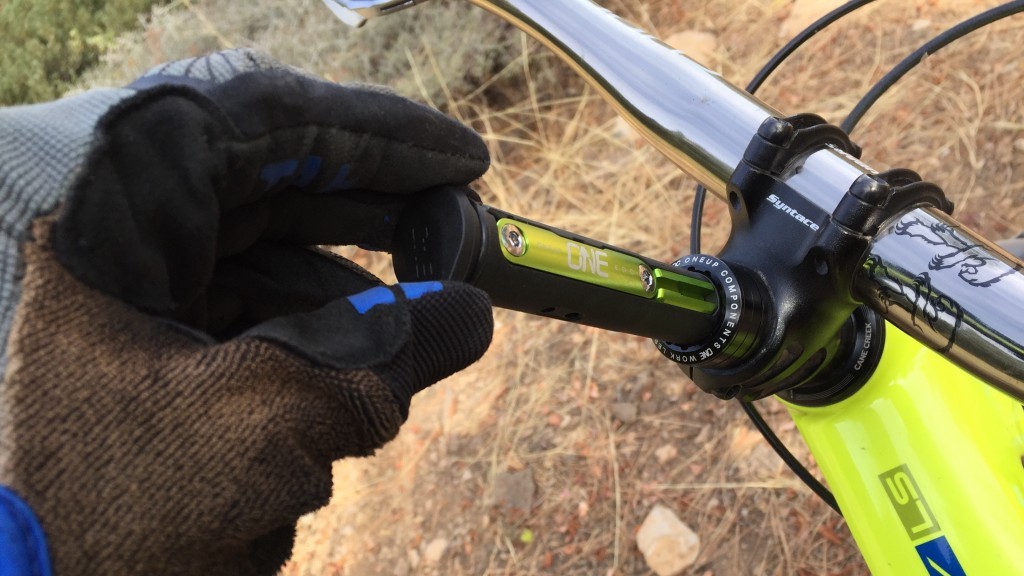OneUp Components EDC Review
Our Verdict
Our Analysis and Test Results
OneUp has made a name for themselves by creating innovative products, some of which solve problems that you never even knew you had. The EDC tool is an excellent example of this, neatly stashing all of your essential trail tools in the empty space of your fork's steerer tube. This novel approach to tool storage gets your tools off your back and on your bike and will have you feeling like Inspector Gadget with your go-go-gadget bike tools close at hand. Admittedly, this unique design seems a little gimmicky, so we tested the EDC to see how it stands up to the competition.
Performance Comparison
Features
With 21 functions, the EDC is about as feature-packed as tools get. What's even more impressive is that OneUp has managed to pack that many tools and functions into the EDC while managing to keep the weight down to 108g, one of the lightest in our test.
The entire system is in several pieces that all fit together neatly. The folding multi-tool contains a 2, 2.5, 3, 4, 5, 6, and 8mm Hex/Allen keys, Torx 25, flat head screwdriver, quick link breaker, and an EDC top cap tool. The chain breaker is a separate piece that has size 0, 1, 2, and 3 spoke wrenches machined into it, the size 3 also doubles as a Presta valve core tool. The chain breaker is attached to the tire lever with a spare chainring bolt. These pieces all fit together and clip into the main body of the unit which has holes to accommodate and store a spare quick link. A hollow plastic chamber threads onto the bottom of the main body of the unit which can fit a threaded 12 or 16g CO2 cartridge.
The tools and functions of the EDC have virtually all of your trail fix needs covered. The only tools that are not included on it, but may be useful for some fixes, are a Torx 10 and a Phillips head screwdriver. If you're the type of rider trying to get away with riding without a pack or just trying to get more weight on your bike and off your back, then this tool has pretty much everything you'll want in the field.
Ergonomics
Overall, testers found the ergonomics of the EDC to be good. In general, the tools are on the smaller side, a result of the compact design and shape of the unit. Due to the small size of the folding multi-tool, for example, it's a little less easy to grasp and also a little harder to torque on when you need serious leverage. The chain breaker is also very compact and slightly more challenging to use than the larger chain tools found on the other models in this review.
While the ergonomics do leave a little to be desired, testers still found them to be better than the clunky design of the Park Tool IB-3. The EDC is almost on par with the Blackburn Tradesman and the Lezyne V10, but the larger overall size of both of those tools makes them both easier to grip. If you're looking for the best ergonomics, the Crankbrothers M19 and Crankbrothers F15 top our test.
Portability
At only 108g, the EDC is competitively lightweight, only 14g heavier than the lightest model in our test. This is quite impressive because it has at least five more functions than each of the three lighter models in our test.
If you were to only look at the measurements of the EDC, however, it probably looks like the least portable of all the tools in the test at 7.5 inches in length. This length is a bit deceptive, considering the fact that it slides into the steerer tube of your fork, making it one of the most portable of all the models tested.
The EDC's portability is limited to bikes that are set up to accommodate the tool with a threaded steerer and special top cap. You can take the tools off the holder and bring them with you in either a pack or a jersey pocket, but if you're planning on having one tool for multiple bikes, we would suggest a different model. OneUp also makes two mini-pumps that can hold the EDC system inside, see the accessories section below for more details.
Ease of Use
The EDC is a bit of an enigma. It is both easier and slightly more difficult to use at the same time. Let us explain. What makes it user-friendly is the fact that it is within arms reach at all times, you never have to take off your pack or search within its depths to find it. You only have to reach down and pull it out of the steerer tube. Once the tool is in hand, it is generally quite easy to use, although it is helpful to familiarize yourself with the tool, all of its functions, and the way things come apart and go back together before using it.
One aspect of the EDC that takes a little getting used to is that it comes apart in three pieces when you use it. The multi-tool is separate from the chain breaker which is attached to the tire lever. You get the idea. If you're used to a multi-tool that is just one unit, like most of the other models in this test, it can be easy to misplace the parts of the EDC. Fortunately, you need all of the pieces to put it back together, which reduces the likelihood of losing them on the trail. The chain breaker is also slightly different than your standard version. The chain doesn't lay flat across it. Instead, it needs to be kinked at a 90-degree angle where you want to press the pin out of it. It works; it's just different.
The elephant in the room in regards to the ease of use of the EDC is the initial setup of the system. To use the EDC as a tool stored in your steerer tube (there is also an EDC Pump option), you need to thread your steerer tube and purchase a OneUp threaded top cap for $25. It's a little bit of a process, but thankfully it only needs to be done once per bike, and many shops have the threading tool and can thread your steerer for you. If you're the DIY type, you can purchase the steerer threading kit for $35 and add it to your tool collection. Once your steerer tube is threaded, and the top cap is installed, you can use the EDC tool as intended. There are how-to videos on the OneUp website should you choose to undertake this process yourself. This is much more involved than merely tossing your new multi-tool into your pack or jersey pocket, a small price to pay if you seek to the convenience that the EDC offers.
Durability
Overall, the EDC appears to be a very well made product. Through the course of our testing, we've been impressed with its durability, and it appears to be in roughly the same condition as it was when we got it. The tools themselves, except for the tire lever, are all made from metal which will probably last for quite a few years if used properly.
Our biggest concern in terms of durability is the copious amounts of plastic used in the unit's construction. That said, the majority of the time, the EDC is sitting motionless in the cramped confines of your steerer tube, and there is zero wear or tear occurring. One would have to go out of their way to break the plastic parts of the EDC tool, but unlike most of the tools in this test with all-metal construction, it is a possibility.
Value
At a retail price of $59, the EDC tool is the most expensive multi-tool in this review. Once you factor in the $25 top cap and the cost of getting your steerer threaded ($35 for the kit), you're looking at approximately $120 for the whole shebang. Because there are very nice multi-tools on the market, several of which are in this review, that cost a third of that price, it's hard to say that this represents a good value. This is one of those rare cases, however, where the end user can only determine the value of a product like this. If you aspire to ride without a pack, or you like to have the coolest new conversation starting bike gear, then perhaps you can justify the expense. Our testers think it is pretty outstanding.
Conclusion
The EDC is a truly impressive and unique multi-tool. It is shockingly lightweight, thoughtfully designed, and packed with virtually every tool you need out on the trail. It slides neatly into your fork's steerer tube for storage and easy access when you need it. Unfortunately, there are obvious disadvantages to this system, most notably the price and the installation process. If you're willing to look past those hurdles, then this is one of the best multi-tools for mountain biking that money can buy.
Other Versions and Accessories
There are a couple of important things you will need to use your EDC tool. An EDC top cap ($25) is required, and they are offered in a variety of colors and weigh only 4.2g. In addition to the top cap, you'll need to have your steerer threaded by a local shop, or you can buy a threading kit ($35), so you can do it yourself.
OneUp also sells two versions of their EDC Pump in which you can store your EDC tool. They make a 100cc ($59) and a 70cc ($55) version, both of which feature an integrated CO2 inflator and come with a water bottle mount.











